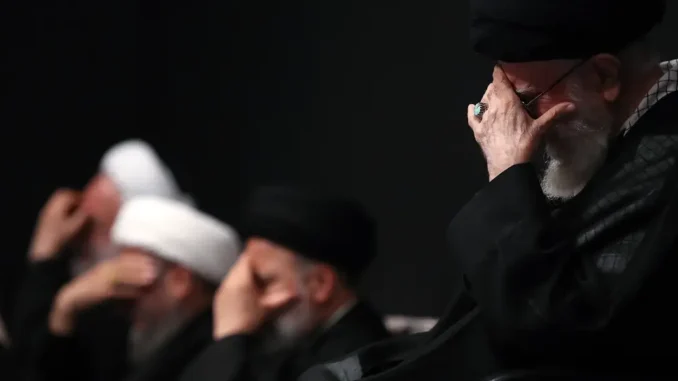Peloni: This article describes the one great strength which the Mullahs have and why they are still in power despite not holding a majority support in Iran: the intractable divisions and conflicting visions which divide the Iranian opposition. In fact, the communists, the royalists, the republicans stand in greater opposition to eachother than they do to the Mullahs. When these divisions are finally ended with a consolidation of support for one of the many dissedent groups or some working coalition, so too will end the rule of the Mullahs.
Iran International Newsroom | May 3, 2024
 Iran’s ruler Ali Khamenei during a religious ceremony in Tehran
Iran’s ruler Ali Khamenei during a religious ceremony in Tehran
A former Iranian regime operative and ideologue, currently residing in Canada, has proposed that opposition forces both abroad and within Iran unite to topple Supreme Leader Ali Khamenei’s rule.
This suggestion has sparked widespread discussion among the Iranian public this week, eliciting divergent reactions. Mehdi Nasiri, the proponent of this contentious idea, previously served as Khamenei’s representative at the hardline newspaper Kayhan and was its chief editor during the late 1980s and early 1990s.
While some view the proposal as an outreach effort by Iran’s reformists to forge an alliance with the country’s opposition abroad, others speculate it may have originated from within the regime’s inner circle to exploit both factions for Khamenei’s benefit.
Nasiri specifically mentioned several reformist figures inside Iran, including Nobel Peace Prize laureate Narges Mohammadi, former president Hashemi Rafsanjani’s daughter Faezeh Rafsanjani, and former deputy Interior Minister Mostafa Tajzadeh, all currently imprisoned in Tehran. He also cited former Prime Minister Mir Hossein Mousavi, who is under house arrest. On the other end of the spectrum, Nasiri referenced Prince Reza Pahlavi, heir to the pre-1979 monarchy, now residing in exile in the United States. He portrayed these individuals as representing opposing poles of the political spectrum capable of forming an alliance against Khamenei.
One of the things that sounds odd about the suggestion is that Nasiri neither represents Prince Reza Pahlavi nor the reformists in Iran. Although he has been criticizing Khamenei during the past two years, he is ultimately a regime insider whose track record includes nothing other than hardline conservatism. He is a man who often claims to have been sending messages directly to Khamenei about the affairs of the state.
Neither the prince, nor the reformists in Iran have shown any reaction to Nasiri’s interview. But politicians and social media users in Iran and abroad have expressed their views about Nasiri’s initiative. According to the reformist daily Etemad, Nasiri’s critics have called him a “super hardliner who now offers suggestions for regime change,” and charged that “Nasiri used to offer guidelines to the regime for suppressing the critics. ”
Mahmoud Sadeghi, a former reformist MP, who like Nasiri used to be a cleric but shed his turban and robe and chose to wear a suit, said in a critical tweet that “Tajzadeh, as a pro-democracy reformist who opposes centralized power, has nothing in common with the prince who believes in hereditary succession.”
Another prominent figure in the reformist camp, Mohammad Ali Abtahi, who served as the chief of staff to former President Mohammad Khatami, offered his perspective on Nasiri’s proposal, stating: “As a former staunch hardliner, Mehdi Nasiri has the right to express his views and transition into a leading opposition figure. However, neither his previous hardline stance managed to undermine the reformist movement, nor does the reform camp require a newcomer like him. Contrary to his assertion, there is little likelihood of collaboration between Prince Reza Pahlavi and Mostafa Tajzadeh, nor does Tajzadeh express any interest in such cooperation. Furthermore, the individuals Nasiri mentioned are currently incarcerated in various forms. It appears someone may be misleading him.
Yet another reformist figure close to the Reform Front, Javad Emam pointed out that “a return to the constitutional monarchy would be a step back. Approaching the prince will be a move in the wrong direction by Iran’s reformists.”
Politicians who belong to the so-called reform camp in Iran are mostly former Islamist or leftist revolutionaries, who are critical of Khamenei but except in a few cases have hardly called for dismantling the Islamic Republic.
On social media, a twitter user who tweets under the alias name Noah’s Wise Son wrote: “It appears that the Islamic Republic and its reform front have no winning card to play. When the Islamic Republic started to groom Nasiri in diaspora media as a reformed Islamic intellectual it was evident that it was a plot to deceive political activists.”
The user suggested that the Islamic Republic and reformists in Iran who have lost their social base, are trying to benefit from the prince’s popularity in Iran. He charged that “those who cooperated with the Islamic Republic to suppress intellectuals and patriotic people wish to cleanse their criminal record by approaching the prince as a popular figure now that the regime is doomed to fall.”
Nasiri says he is visiting his son who is a student in Canada and will return to Iran at a later date, but if what he says is his genuine idea, he can hardly get away with its consequences once he sets foot in Tehran.
A different scenario neither Iranian politicians, nor social media users have thought of is the possibility of Nasiri being a messenger from Khamenei who is either trying to save a regime that has lost the nation’s support and trust or in a more complicated game, he is tasked by Khamenei to discredit both the royalists and the reformists.



… and the support of the Bho/JB Adm!!!